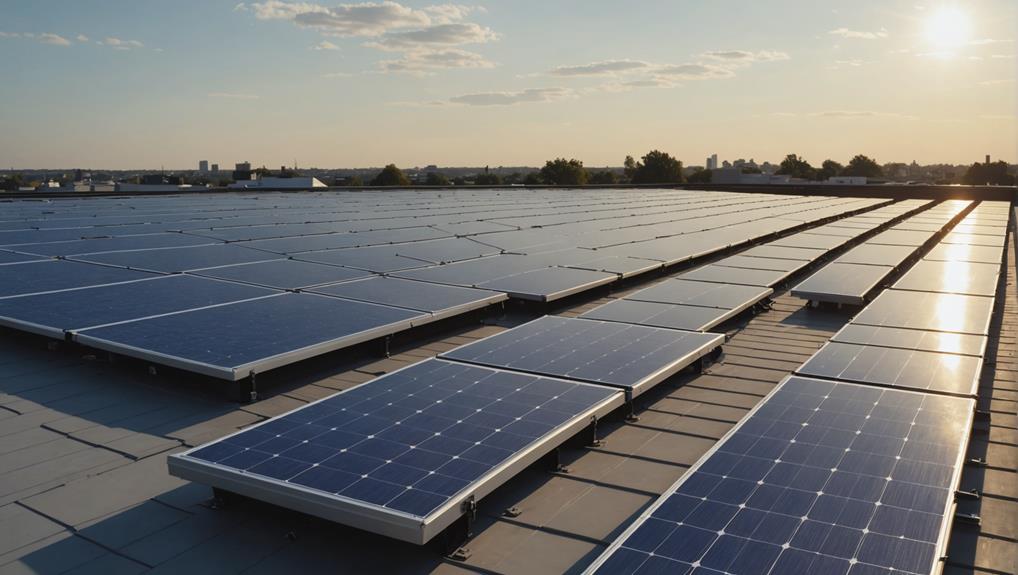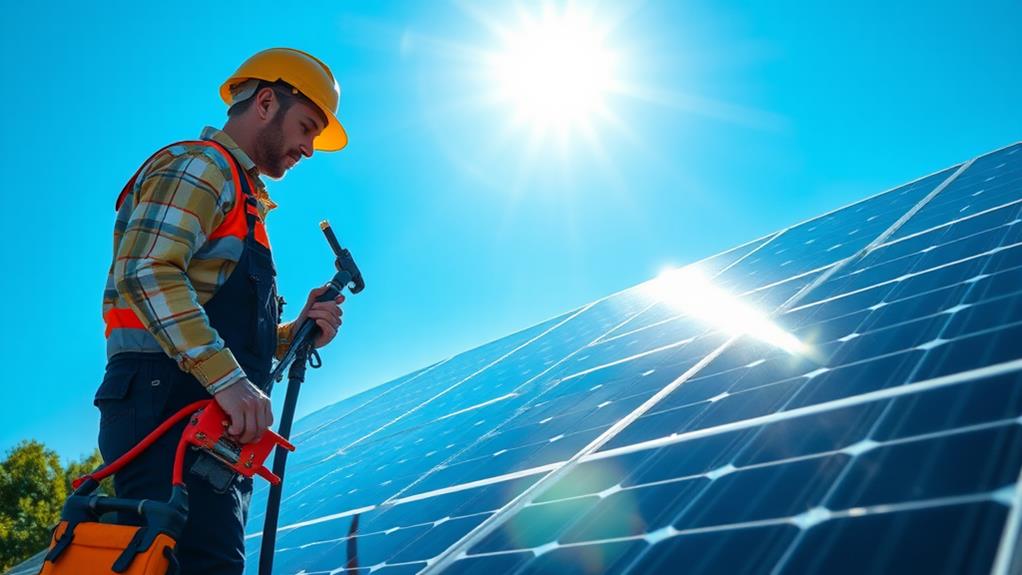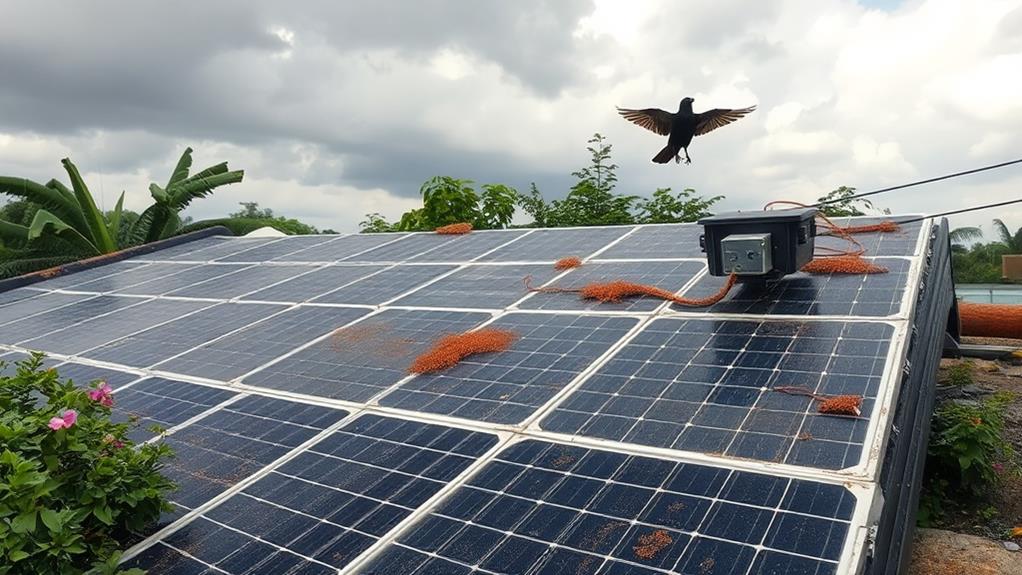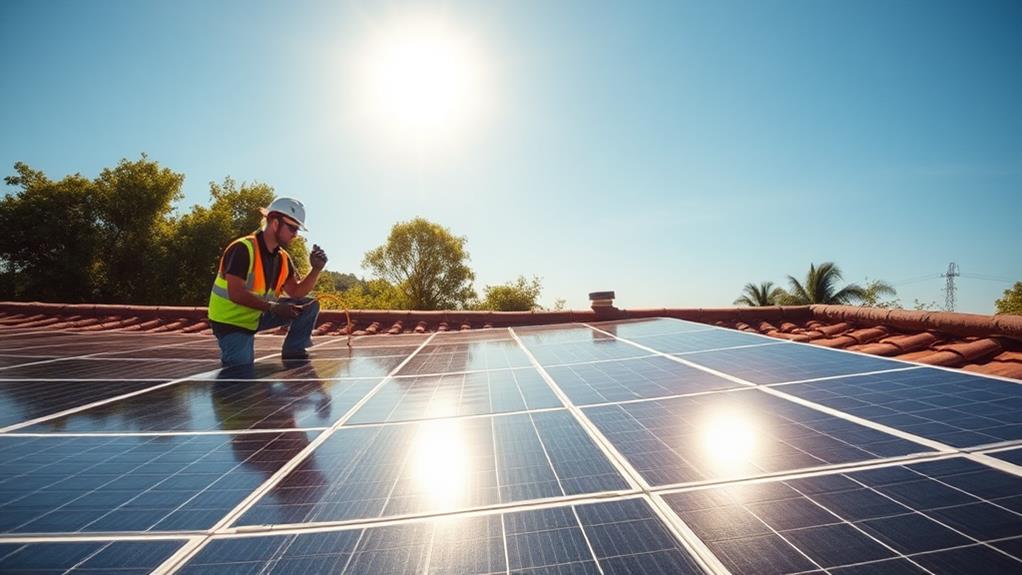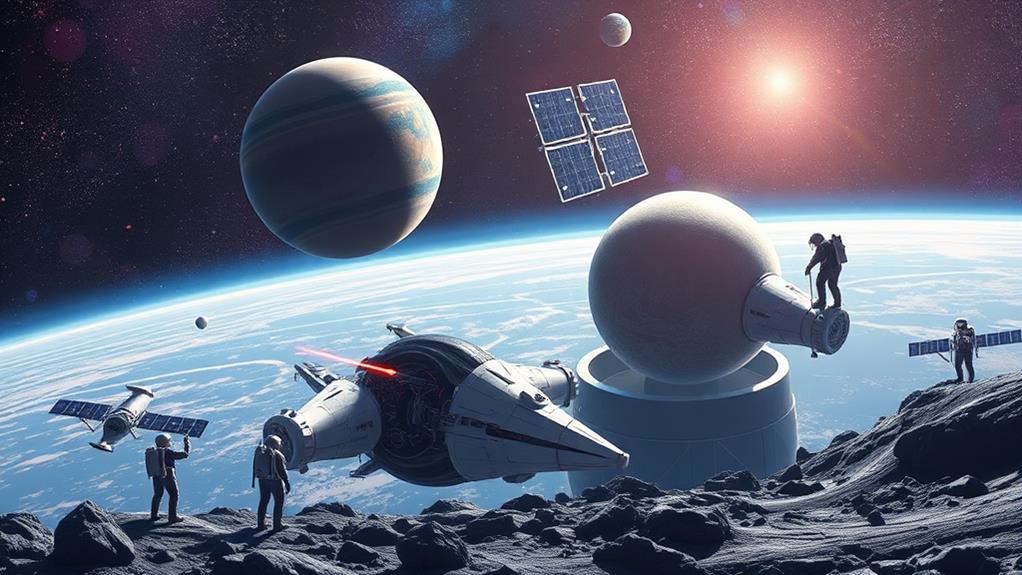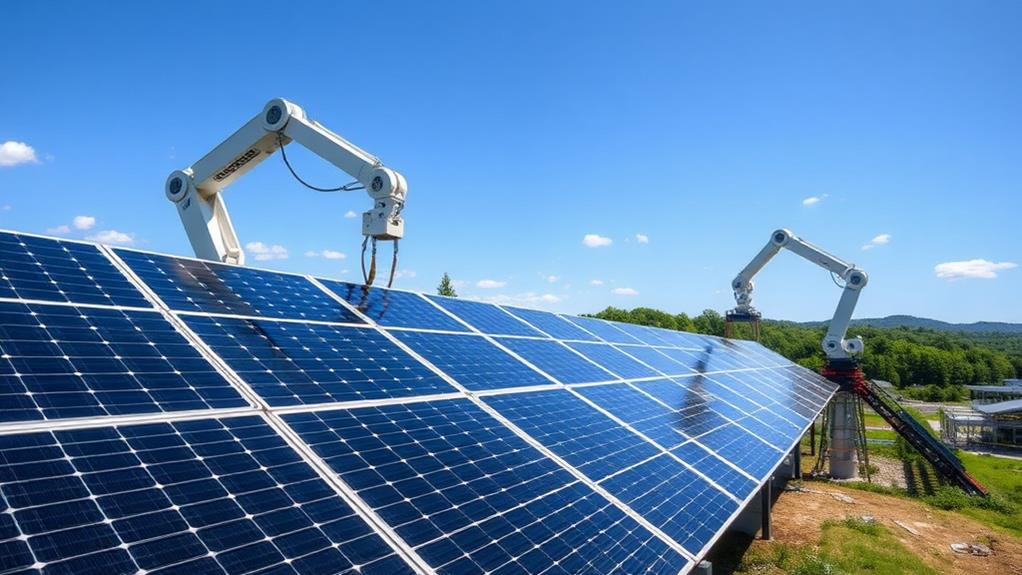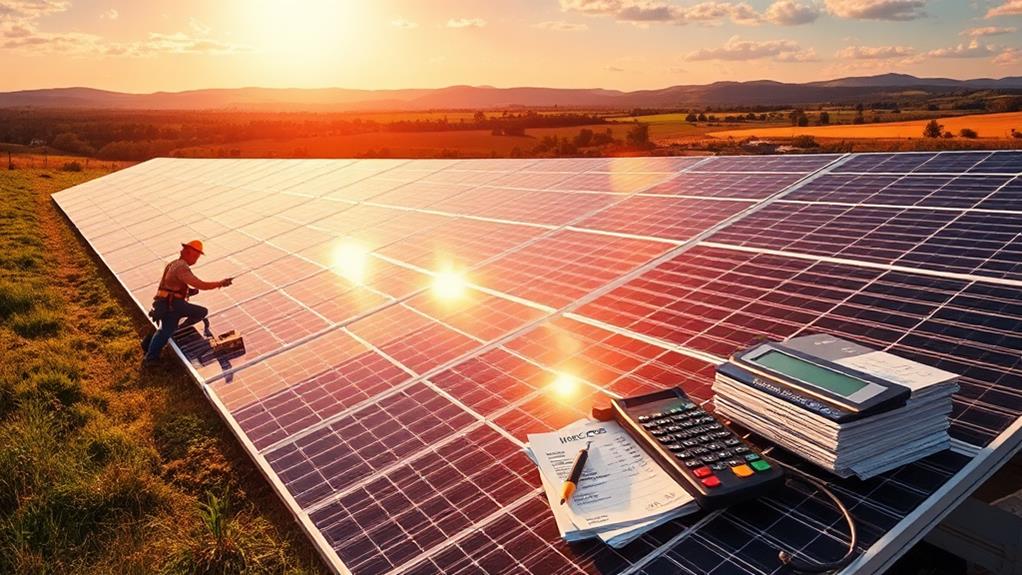The choice of solar mounting system depends on the specific application and location.
For residential and commercial use, roof mounting systems are a popular option, with flush and tilted mounts being ideal for maximising energy yield.
Ground mounting structures, on the other hand, offer a versatile solution for diverse landscapes.
Other types of solar mounting systems include carport mounting systems, which provide shelter for vehicles, and floating mounting systems, which can increase energy production.
Tracking mounts are also a valuable option, as they can enhance energy capture by up to 40%.
By understanding the different types of solar mounting systems and their benefits, individuals can find the best fit for their solar energy needs.
Solar Mounting System Overview
Within the context of solar energy systems, a solar mounting system provides a stable base for solar panels to operate efficiently. This stability is essential for guaranteeing the optimal performance of the solar panels, as it allows for the precise angling of the panels to optimise sunlight exposure.
A well-designed solar mounting system improves installation safety, preventing toppling and reducing the risk of damage and injury. Properly installed solar mounting systems reduce the risk of accidents and ensure that the solar panels remain securely fastened, even in harsh weather conditions.
The right mounting system ascertains that solar panels are installed with the utmost care, providing a secure and efficient source of renewable energy. Prioritising solar panel stability and installation safety enables individuals to reap the full benefits of their solar energy systems, contributing to a more sustainable future.
Types of Solar Panel Mounts
Solar panel mounting systems are categorised into several types, each designed to cater to specific installation requirements and environments. The most common types include Roof Mounting Systems, Carport Mounting Systems, and Tracking Mounts.
Roof Mounting Systems utilise various methods, including flush mounts and tilted mounts, making them ideal for residential and commercial applications. For instance, the Renusol CS Forged Rail system is a popular choice for roof mounting, offering a secure and adjustable solution.
Carport Mounting Systems serve a dual purpose, providing shade for vehicles while generating solar energy, with variations that optimise vehicle access and aesthetics. The Schletter Carport system is a notable example, offering a sturdy and versatile solution for carport installations.
Installation techniques and energy efficiency are vital considerations when selecting a solar panel mounting system. Tracking Mounts, for example, can increase energy production by up to 40% compared to fixed installations, as they adjust the position of solar panels to follow the sun's path.
This type of system is particularly effective in locations with high solar irradiance, such as the sun-rich regions of South Africa. The AllEarth Solar Tracker is a recommended option for tracking mounts, offering a reliable and efficient solution.
Effective mounting systems are fundamental for maximising energy production and minimising maintenance. Individuals can choose the most suitable option for their specific needs, enhancing the overall energy efficiency of their solar panel system.
Ground Mounting Structures
Ground mounting structures offer a versatile solution for maximising solar energy yield, as they accommodate varying site topographies with flexible panel placement options. This adaptability makes them an ideal choice for locations with diverse landscapes.
There are three variations of ground mounts, each with its own unique characteristics: GM Economical and GM Exclusive, which utilise hot-dipped galvanised steel, and GM Elite, which is made from aluminium for improved durability. The foundation types for ground mounts include pile-type or block-shaped designs, both sized according to Axe Struct specifications to guarantee stability.
The advantages of ground mounts are numerous, including simplified installation and maintenance due to their fixed tilt design. This design also contributes to installation efficiency, as the panels are positioned at a fixed angle, eliminating the need for complex adjustments.
Ground-mounted systems are particularly advantageous in locations with ample land space, allowing for easier access for maintenance and potential expansion of solar installations. For instance, the GM Elite's aluminium construction makes it a reliable choice for withstanding harsh weather conditions.
Individuals and organisations can join the community of solar energy adopters, contributing to a more sustainable future for all. Ground mounting structures provide a reliable and efficient solution for harnessing solar energy.
Roof Mounting System Options
As the solar industry evolves, roof mounting system options have emerged as a crucial component in harnessing solar energy. Eight alternatives are available, including Railless, Railed, Angled Railed, and Ballast Railless, each designed to optimise solar panel placement based on specific roof types and conditions.
Railless systems eliminate structural elements, reducing material requirements while maintaining effective panel support, making them a viable solution for many residential and commercial buildings.
Angled mounting solutions, such as the A-frame concept, improve energy production by positioning panels at optimal angles for sunlight exposure. The Inroof system integrates solar modules directly into the roofing material, serving as a waterproof cover and boosting aesthetic appeal through seamless integration. For instance, the Inroof system is ideal for flat roofs, while the Angled Railed system is better suited for sloped roofs.
The Ballast Railless system, on the other hand, is a good option for metal roofs, as it does not require penetration.
Roof mounting systems are designed to be compatible with various roof types, ensuring optimal efficiency across diverse architectural applications. For example, the Renusol CS Railless system is a suitable option for flat roofs, offering a cost-effective solution without compromising on performance.
In contrast, the K2 Domesic system is better suited for pitched roofs, providing a secure and adjustable mounting solution.
Floating Mounting System Benefits
Floating mounting systems have revolutionised the solar industry, providing a unique solution for harnessing solar energy on water bodies such as lakes and reservoirs. These systems utilise buoyant platforms made from high-density polyethylene (HDPE) and aluminium, thereby decreasing land use while maximising solar energy capture.
A primary benefit of floating mounting systems is their potential for efficiency improvement. As the solar panels are installed on water, they benefit from cooling effects, which can increase their efficiency and energy output compared to traditional ground-mounted systems. For instance, a study on a floating solar installation in the UK found that the cooling effect of the water increased the energy output of the solar panels by up to 15%.
Additionally, floating solar installations can reduce water evaporation and algae growth in reservoirs, contributing to environmental benefits beyond energy generation. The use of floating mounting systems, such as those offered by UK-based company, SunDock, can contribute to a more sustainable and efficient solar energy solution.
In regions with limited available land for solar energy development, such as South Africa, floating mounting systems can provide a compelling alternative, utilising dual land and water resource utilisation. Overall, floating mounting systems offer a sustainable and efficient solution for solar energy generation, minimising environmental impact while maximising energy output.
Carport Mounting System Features
Carport mounting systems are increasingly being utilised to generate solar energy whilst providing shelter for vehicles, thereby optimising land use in parking lots and garages. This innovative approach not only reduces the urban heat island effect but also improves the overall visual appeal of the surrounding area.
Carport mounting systems offer several benefits, including:
- Durable and long-lasting: Engineered to withstand environmental conditions, these structures guarantee durability and longevity with high-quality materials, such as galvanised steel and anodised aluminium.
- Design flexibility: Available in three variations (CP Economical, CP Elite, CP Exclusive), carport mounting systems cater to diverse needs, from non-cantilevered to full cantilever designs, allowing for bespoke solutions to suit specific requirements.
- Aesthetic appeal: These systems are designed to blend seamlessly with existing infrastructure, improving visual appeal and design aesthetics, and can be tailored to complement surrounding architecture.
- Environmental benefits: Providing shaded parking and reducing heat islands, carport installations contribute to enhanced energy efficiency and sustainability efforts, such as reducing the carbon footprint of a building. For instance, a carport installation with a capacity of 100 kWp can reduce CO2 emissions by approximately 150 tons per annum.
The CP Elite carport mounting system, for example, is a popular choice for its durability and versatility, offering a robust and long-lasting solution for commercial and residential applications.
Key Considerations for Selection
When selecting a solar mounting system, several key factors must be evaluated to ensure a successful and efficient installation. The geographic location and climatic conditions, such as sunlight availability and wind load potential, are critical factors that influence the choice of solar mounting systems.
For instance, in areas with high wind loads, a sturdy mounting system like the Renusol CS is recommended. The type and condition of the roof, including its weight capacity and slope, must also be assessed to confirm compatibility with the selected mounting system.
The roof's material and age are also crucial considerations. For example, a roof with a low weight capacity may require a mounting system with a low footprint, such as the S-5! clamping system.
Budget considerations, including the initial investment cost versus long-term savings, play a significant role in determining the most suitable mounting solution for solar panels. An installation cost analysis should be conducted to evaluate the total cost of ownership, including the cost of materials, labour, and maintenance, which can range from R50,000 to R200,000, depending on the system's complexity.
The mounting material's durability should be considered to confirm that the system can withstand different environmental conditions. For instance, a mounting system made from corrosion-resistant materials like aluminium or stainless steel is ideal for coastal areas.
Comprehending local regulations and zoning laws is also crucial, as they may dictate the feasibility and design requirements for solar installations. In South Africa, for example, the National Building Regulations and Building Standards Act must be adhered to.
Maintenance and Longevity Factors
Several factors contribute to the maintenance and longevity of solar mounting systems, with regular inspections being a crucial aspect of guaranteeing their efficiency and longevity.
Regular inspections help identify potential issues early on, preventing minor problems from becoming major ones. To guarantee the optimal performance of solar mounting systems, consider the following key maintenance and longevity factors:
- Regular Inspections: Regular inspections identify potential issues early on, preventing minor problems from becoming major ones. For instance, a thorough inspection can reveal loose connections or damaged components, allowing for prompt rectification.
- Effective Cleaning Techniques: Periodic cleaning of solar panels and mounts improves efficiency and performance by removing dirt and debris that can obstruct sunlight. Utilise a soft-bristled brush and mild detergent to clean solar panels, ensuring a gentle yet effective clean.
- High-Quality Materials: High-quality materials used in mounting systems improve weather resistance, guaranteeing durability against harsh environmental conditions and extending their lifespan. Consider mounting systems made from corrosion-resistant aluminium or stainless steel, such as the Sapa Solar Mounting System.
- Warranty and Support: Most solar mounting systems come with warranties that protect the investment, offering peace of mind regarding maintenance and replacement costs. Look for manufacturers that offer comprehensive warranties, such as the 10-year warranty provided with the Schletter Solar Mounting System.
Future Trends in Mounting Systems
The solar industry is experiencing a surge in innovative mounting system designs and technologies, enhancing efficiency, sustainability, and adaptability. A key trend is the growing adoption of dual-axis trackers, which can increase energy capture efficiency by up to 40% compared to fixed systems.
Floating solar installations are also gaining popularity, particularly in areas with land constraints, as they offer creative land use and water cooling benefits. Advancements in materials science have led to the development of lighter, more durable mounting solutions, including eco-friendly designs that minimise environmental impact.
Market predictions indicate that the integration of smart technology into solar mounting systems will continue to drive performance and efficiency improvements.
Urban areas are embracing solar canopies and automated installation processes, reflecting a growing trend towards sustainability and hybrid systems that combine solar with other renewable energy sources. Examples include solar carports and building-integrated photovoltaics (BIPV) systems.
Companies such as SunPower and Trina Solar are already offering innovative mounting solutions that cater to diverse needs and environments, further solidifying solar energy's position as a leading source of renewable energy.
Conclusion
Deo Solar's range of solar mounting systems are crucial for optimising energy production and ensuring the longevity of solar panel installations. We offer various types of solar mounting systems, including Ground Mounted Solar Systems, Roof Mounts, Floating Mounts, and Carport Mounts, each with unique benefits and considerations. As the solar industry evolves, advancements in mounting system technology are expected to improve efficiency, durability, and cost-effectiveness. At Deo Solar, we provide a range of innovative products, including Rail-Less Solar Brackets, End Spacers, Structural Brackets, Corrugated Brackets, and Earthing Plates. If you have any questions about our products or services, which include the DeoSizer Tool, Evaluation and Design, Maintenance and Support, and Solar Installations, please do not hesitate to contact us. We invite you to get in touch with Deo Solar to discuss how our solutions can meet your specific needs.

